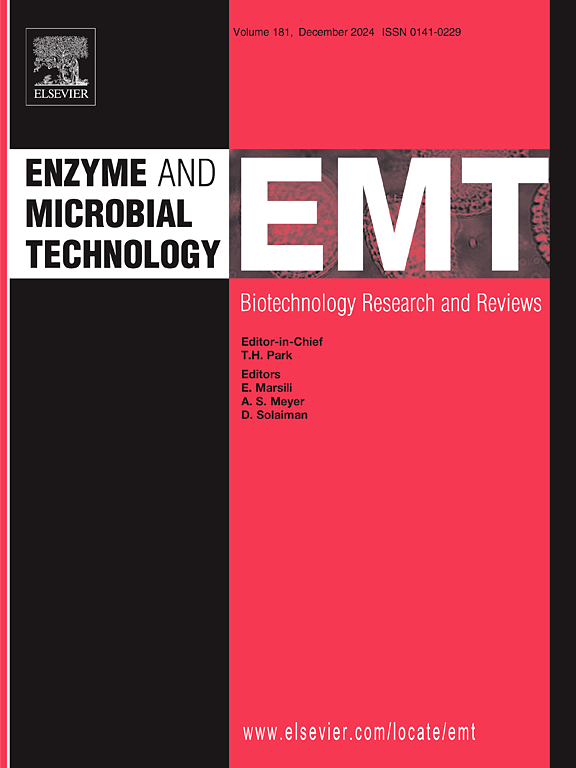Efficient isoprimeverose production using an enzyme cocktail from engineered Aspergillus oryzae and yeast-assisted purification
IF 3.7
3区 生物学
Q2 BIOTECHNOLOGY & APPLIED MICROBIOLOGY
引用次数: 0
Abstract
Aspergillus oryzae is a filamentous fungus that possesses various types of carbohydrate -degrading enzymes. Among these, isoprimeverose-producing enzyme (IpeA), acts on a key component of the plant cell wall structure, xyloglucan, to catalyze the release of isoprimeverose — a rare disaccharide that is expected to possess valuable prebiotics properties. Despite these expectations, however, a process for the effective production of isoprimeverose from the xyloglucan still requires further development for commercial-level application. A complicating factor for the lack of such a valuable process is that plant-derived xyloglucan is often modified with other sugars such as galactose and arabinose. Therefore, the effective production of isoprimeverose requires a cooperative form of degradation that must utilize different enzymes. In this study, we genetically engineered two A. oryzae strains — one produces IpeA and the other produces endoglucanase. The two strains were cultivated separately, and an enzyme cocktail was prepared using their respective culture supernatants. This enzyme cocktail successfully produced isoprimeverose from tamarind xyloglucan and tamarind seed gum. Approximately 14 g/L of isoprimeverose was obtained, which corresponds to a theoretical conversion rate of over 90 %. Although glucose and galactose remained in the reaction solution after enzymatic degradation, these by-products could be easily removed via treatment with Saccharomyces cerevisiae. Our developed process, which mimics traditional Japanese sake fermentation using A. oryzae and S. cerevisiae, has enabled efficient production of isoprimeverose.
利用工程米曲霉和酵母辅助纯化的鸡尾酒酶高效生产异戊糖
米曲霉是一种丝状真菌,具有多种类型的碳水化合物降解酶。其中,异基戊糖生成酶(IpeA)作用于植物细胞壁结构的关键成分木葡聚糖,催化异基戊糖的释放,这是一种罕见的双糖,有望具有宝贵的益生元特性。然而,尽管有这些期望,从木葡聚糖中有效生产异戊糖的工艺仍需要进一步开发以实现商业应用。缺乏这样一个有价值的过程的一个复杂因素是,植物衍生的木葡聚糖经常被其他糖修饰,如半乳糖和阿拉伯糖。因此,异戊糖的有效生产需要一种协同降解形式,必须利用不同的酶。在这项研究中,我们对两株稻谷曲霉进行了基因工程改造,一株产生IpeA,另一株产生内切葡聚糖酶。分别培养两株菌,用各自的培养上清配制酶鸡尾酒。该酶混合物成功地从罗望子木葡聚糖和罗望子籽胶中生产出了异丙糖。得到的异戊糖约为14 g/L,理论转化率为90 %以上。虽然葡萄糖和半乳糖在酶降解后仍留在反应溶液中,但这些副产物可以很容易地通过酿酒酵母处理去除。我们开发的工艺,模仿传统的日本清酒发酵,使用米曲霉和酿酒酵母,使异戊糖的高效生产成为可能。
本文章由计算机程序翻译,如有差异,请以英文原文为准。
求助全文
约1分钟内获得全文
求助全文
来源期刊

Enzyme and Microbial Technology
生物-生物工程与应用微生物
CiteScore
7.60
自引率
5.90%
发文量
142
审稿时长
38 days
期刊介绍:
Enzyme and Microbial Technology is an international, peer-reviewed journal publishing original research and reviews, of biotechnological significance and novelty, on basic and applied aspects of the science and technology of processes involving the use of enzymes, micro-organisms, animal cells and plant cells.
We especially encourage submissions on:
Biocatalysis and the use of Directed Evolution in Synthetic Biology and Biotechnology
Biotechnological Production of New Bioactive Molecules, Biomaterials, Biopharmaceuticals, and Biofuels
New Imaging Techniques and Biosensors, especially as applicable to Healthcare and Systems Biology
New Biotechnological Approaches in Genomics, Proteomics and Metabolomics
Metabolic Engineering, Biomolecular Engineering and Nanobiotechnology
Manuscripts which report isolation, purification, immobilization or utilization of organisms or enzymes which are already well-described in the literature are not suitable for publication in EMT, unless their primary purpose is to report significant new findings or approaches which are of broad biotechnological importance. Similarly, manuscripts which report optimization studies on well-established processes are inappropriate. EMT does not accept papers dealing with mathematical modeling unless they report significant, new experimental data.
 求助内容:
求助内容: 应助结果提醒方式:
应助结果提醒方式:


